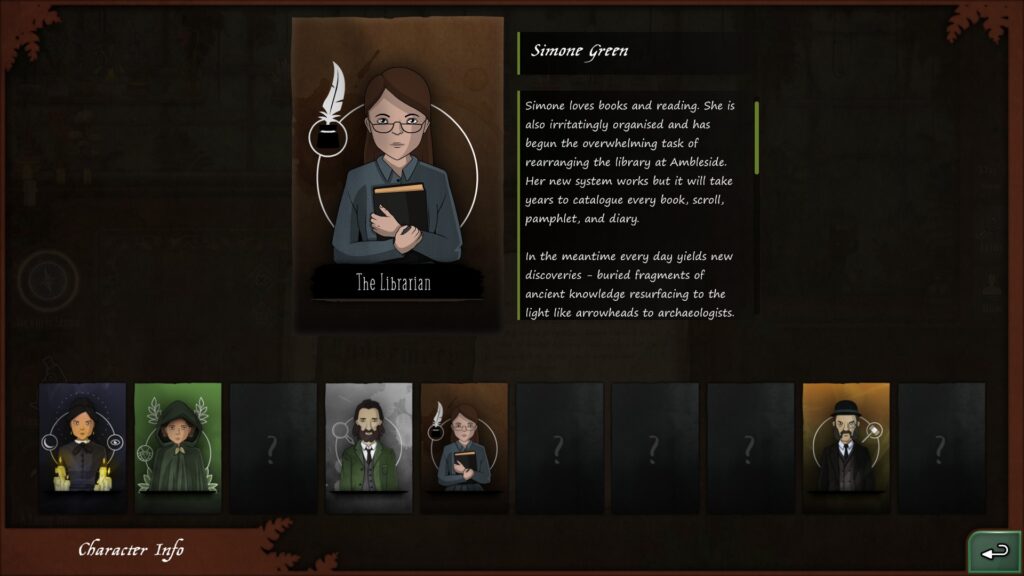
You receive a handwritten note regarding the whereabouts of the Wandering Bue. It is signed by Simone, the librarian in the game Strange Horticulture. Throughout the story, she does what librarians stereotypically do: provide information. She spends so much time working, in fact, that it leads to health decline. It doesn’t help that she knows dangerous information that puts her in potential danger. Is Strange Horticulture crafting a dramatic depiction of librarianship, or is it unexpectedly mirroring real-world experiences? Perhaps there is more to librarianship than meets the eye. Let’s investigate.
Fictional Plants, Black Cats, and Ancient Evils
Strange Horticulture is a 2022 2-D occult-themed puzzle game by developer Bad Viking. The player is the new owner of a plant shop which sells fictitious plants to the people of rainy Undermere. As a player, you spend a lot of time matching physical plants with their descriptions by using clues. The plants and descriptions can range from realistic to fantastical, like the Aguria, which “can enhance psychic abilities, strengthening the clarity of visions and prophecies.” As plants/descriptions are matched and are unlocked, a plant catalog expands, becoming an increasingly helpful resource for further player sleuthing.
Most of the game takes place on a screen with a dark wooden table, plant shelves, and a sepia text box. There are old letters and a worn-out map. Some other charms of the game include Hellebore, the shop’s black cat; the “A rising Dread” meter (when filled, you will get flagged with: “A shiver travels down my spine. My mind is broken.”); a foreboding deck of cards describing the past, or the future…
As the player meets more people, they learn about “an ancient evil” called the Servant, the Woken Dendrew. Some people seek to destroy the creature, others try to control it. The Servant’s release, and the fate of the characters, depend on the player’s decisions. Though it sounds tense and unsettling, Strange Horticulture is actually a rather calm, relaxing cozy game where deaths and horrors are treated like gossip through dialogue. It also leans on text-based narration, which the player can take their time reading and re-reading for clues. With multiple endings, choices matter in Strange Horticulture.
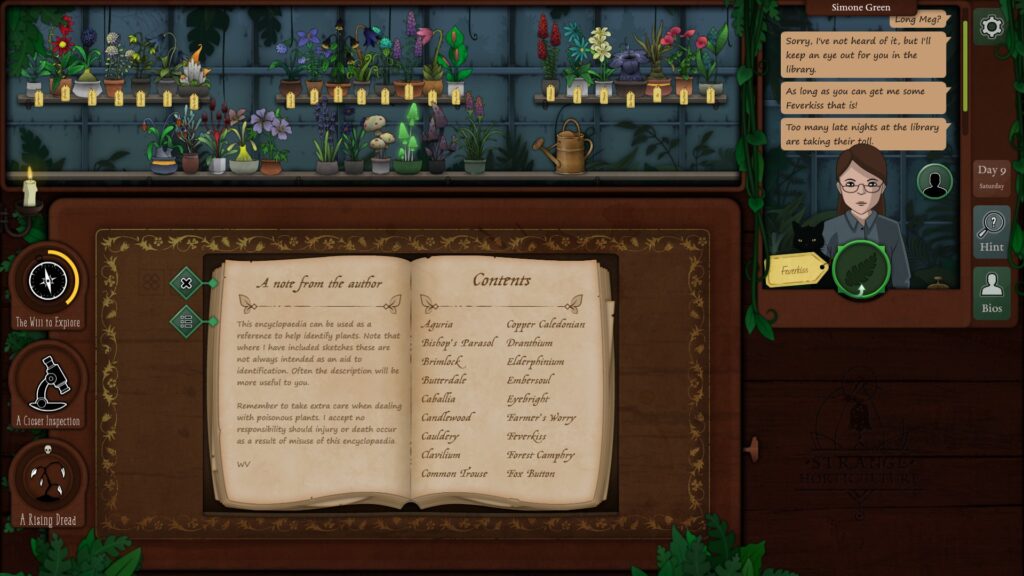
Simone Greene, the Overworked Librarian
Simone Greene is a librarian at Ambleside Library (fun fact: While Undermere is a fictional place, Ambleside is a real town in the U.K. with a real library). At first glance, Simone is a stereotypical librarian. She is a conservatively dressed white woman wearing glasses and holding a book (granted, the game is Victorian-inspired). Though she is not as mysterious as the “Woman in the Jade Mask” or “The Hunter”, she is significant enough to be one of ten characters who have a biography and title (“The Librarian”), among the dozens of characters in Strange Horticulture.
Simone loves reading and is “irritatingly organized.” She provides clues and narrative tidbits that move the plot along. “You owe me for the hours I spent digging out the information on those plants!” she exclaims. She’s well connected and is able to gain access to the library at Calder Abbey as well as the archives of Lord Fremont. Simone is very passionate about knowledge, enduring sleepless nights in order to gather information. When she visits the plant shop, it is to get plants to help with eye strain or boost energy. “Too many late nights at the library are taking their toll,” she says.
Is this a realistic depiction of librarians? Is it stereotypical? And whatever it may be, is the depiction itself helpful or harmful for real-world librarians?
The article “Vocational Awe and Librarianship: The Lies We Tell Ourselves” discusses how people expect libraries, and librarians, to do an extraordinary amount of good and important work. Librarians are pressured to sacrifice a lot to provide quality service, and if they fail, the blame ends up on the librarian, instead of the library system (or society in which it resides). As a result of this mistreatment, librarians experience job creep, under-compensation, and ultimately, burnout, while the flawed system remains unchanged. Let’s look at how much of that lines up with Simone’s experience.
Simone’s perpetual exhaustion is mentioned in a casual off-handed tone, but it echoes reality. For one, public librarians often experience things like irregular shifts. “Librarians, especially public librarians, typically do shift work, covering some evenings and weekends, often on a rotating schedule. Even more disruptive to regular eating and sleeping patterns, those shifts tend to be irregular from day to day and week to week. Studies on the effects of shift work have found negative impacts on mental health as well as physical health. The two are often intertwined, such as when disrupted sleep cycles contribute to stress.” Simone expressed these sentiments herself, “I’ve been burning the midnight oil again and could use some Common Trouse.” Plant description: “Its leaves have been used for centuries as a balm against eye strain.”
Librarians also typically perform beyond their job description. People expect “someone who can offer emotional support, reassurance, sociality, answers, and interventions at points of pain or need” ( the mommy librarian—note the gendering). Luckily, Strange Horticulture doesn’t imply this kind of relationship. If anything, Simone and the player are friends and Simone herself is approachable and friendly. Simone’s fond of the shop cat (“Hellebore! Always a pleasure my feline friend.”) and the player knows Simone’s mother, “My mother’s had me looking into this Servant creature for you…” Instead, Simone performs beyond her job description in other ways. Another “positive” for her depiction is that she is enjoying her work. Her biography states, “In the meantime every day yields new discoveries – buried fragments of ancient knowledge resurfacing to the light like arrowheads to archaeologists.” It seems her curiosity, not an abusive work environment, is the source for her crazy work schedule (though passion should not be exploited for unreasonable labor). But for real-world librarians, especially women who have to deal with all the issues described above, “burning the midnight oil” every night will just lead to burnout.
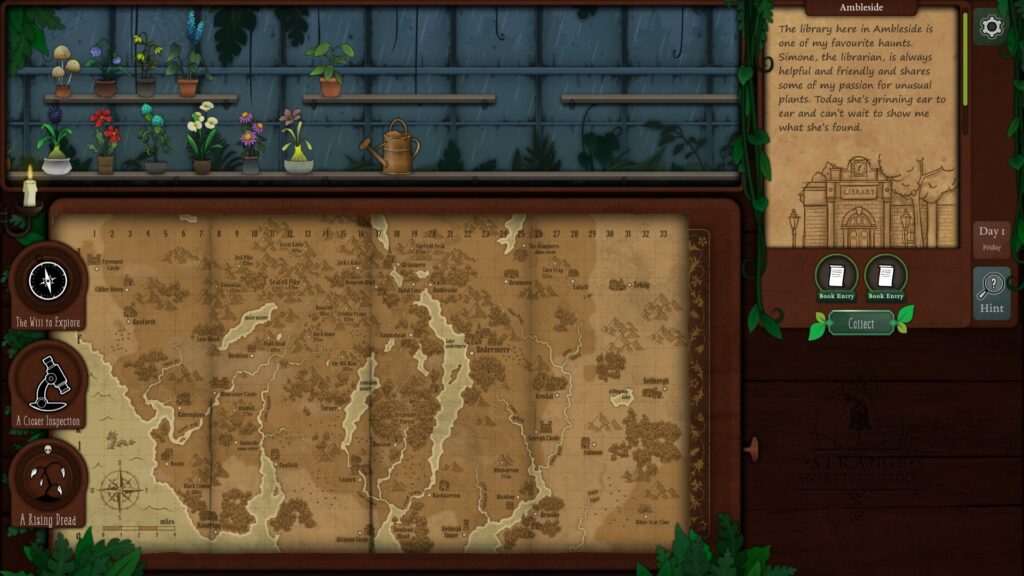
A Well-Read Woman is a Dangerous Creature
Though stereotyped to be a feminine field, librarianship wasn’t always a “women’s profession.” In fact, Victorian era male librarians thought the job was actually too much for women. “The belief that long hours or excessive intellectual stimulation could make women sick presumably led some women to avoid seeking additional responsibilities. In other cases supervisors—both male and female—held them back for the sake of their health.” This was a time when men thought even reading was bad for women (Madame Bovary, anyone?).
For a nineteenth century woman, Simone is pretty radical. She overcomes the sexism of her time by being well-read on a wide range of topics. She works hard and “has begun the overwhelming task of rearranging the library at Ambleside.” That said, Simone may not seem extraordinary feminist today because players see Simone through a contemporary lens, not a historic one. How does she hold up to the modern woman?
Though her work ethic is admirable in the game, she somewhat plays into certain expectations, described by “The Stereotype Stereotype,” “By 1900, the passive, submissive, and plain librarian stereotype we recognize today had emerged. Women were hired to take over the less desirable aspects of librarianship and were paid low wages because they had no leverage.” Simone’s intelligence actually plays into that stereotype. “Administrators endeavored to hire women because they were better educated than men attracted to the profession and were unable to demand comparable wages.” Of course, pay inequality is a problem today. A 2020 study shows that, at least in research libraries, “While better than the US overall pay gap, males at every level make significantly more, both statistically and in terms of lost wages during the course of a career, than their female colleagues.”
Let’s explore Simone’s intelligence a bit more. Simone is smart (as librarians are portrayed), but this is depicted in a realistic way. She says things like, “I have no idea what any of this means,” or “Sorry, I’ve not heard of it, but I’ll keep an eye out for you,” or even “I’m drawing a blank when I try to find anything.” Rather than being a know-it all, she’s down-to-earth. These remarks help make Strange Horticulture more interesting by enhancing the narrative or creating puzzles while making Simone more relatable.
The knowledgeable librarian/curator/historian/archivist is a common trope (think Blathers in Animal Crossing) but this stereotype can easily gloss over actual effort. Compare Blathers’ instant monologues to Simone’s research attempt: “In reference to your question the other day about Long Meg, I’m afraid I do not have an answer but Calder Abbey has a wealth of knowledge on local lore.” This shows the labor of librarianship. It is also realistic for librarians to say “I don’t know” and to recommend a place to start researching. It makes her more believable (unlike Urag gro-Shub in the College of Winterhold, who is at his desk 24/7).
Librarians are seen as knowledgeable because they manage, well, knowledge. Like Simone, many real-world librarians help patrons find information. Reference librarians are generally trained to direct patrons resources such as books, shelves, digital repositories, and other libraries altogether. Simone does twice – the first time, she sends the player to Calder Abbey; the second time, to Lord Fremont’s archives. That said, most librarians don’t comb through books and send personalized notes like Simone. That would lean to burn out, and people shouldn’t expect that of librarians. But at least she isn’t playing into the shushing old lady librarian lady trope like Wickerbottom from Don’t Starve, another well-read and plant-obsessed librarian.
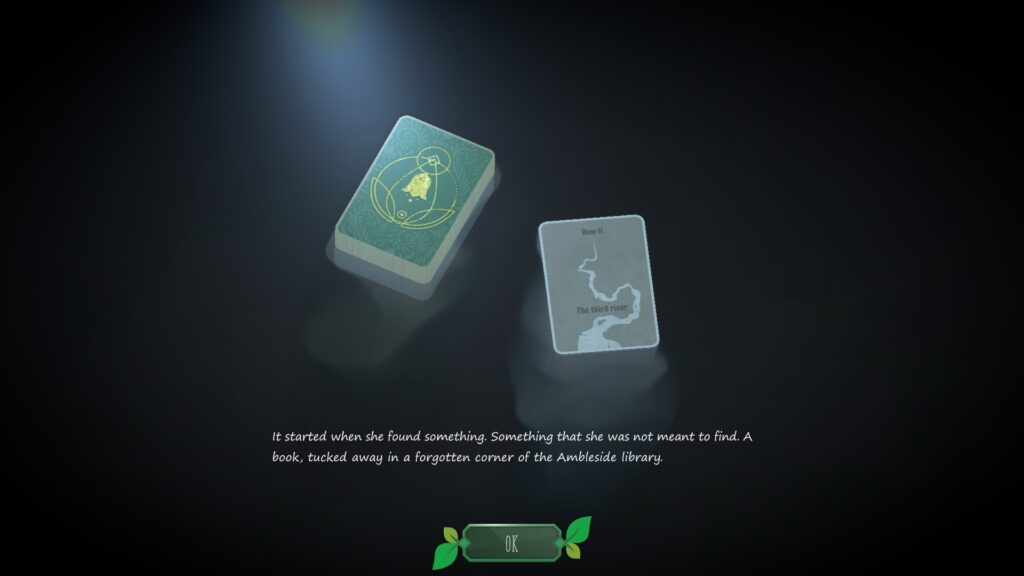
Librarians Under Attack
While Simone’s physical health is casually eroded away by her career, her life is threatened by something much more sinister. Regardless of the player’s choices in the game, there will always be the option midway through to “drug” Simone on Day 12. That day, Faye (“The Psychic”) arrives at the plant shop and hands the player Lisle of Neptune. “When your librarian friend visits tomorrow, give her this instead of the Palliance that she will ask for. She knows something that she’s not telling you.” The Lisle of Neptune’s description: “Also called Truthsayer, this plant will force a person to tell the truth when eaten.”
The next day, Simone visits the plant shop. She requests Palliance, which improves air quality. The player can give her a Lisle of Neptune plant instead – if chosen, Simone suddenly “volunteers” the recipe for the Elixir of Control. The elixir controls the Servant, and many people want that power. Later, Simone says, “I haven’t forgiven you for whatever it was that you gave me the other day.” Danger is real in Strange Horticulture; mysterious disappearances and murders are key to the storyline. But how often do librarians deal with serious matters like threats and death?
When people think of libraries, they usually imagine books and computers. They don’t usually imagine crisis management. Sure, that’s not as exciting as a summoning ritual of an immortal monster, but still pretty serious. Libraries have become complex spaces. Librarians now need to know how to perform de-escalation techniques and administer naloxone. They also deal with safety issues (or, perhaps, issues are finally coming to light). Library staff get sexually harassed and sometimes train to protect themselves from stalkers. In 2018, a public library supervisor in California was killed by a gun-wielding patron. An article from American Libraries Magazineprovides examples of abuse in the library space, and lists other violent moments from 2017-2019. Library staff sometimes have a plan in place to deal with workplace violence, but the fact that they have to deal with so many things shows how the expectations/demands have grown (job creep). Recently, librarians experienced trauma due to a global pandemic and dealt with discriminatory protestors (more on that later). Funding, training, salary, and work/life balance has not kept up.
Though Simone is not as embedded in the dramatics of the story, she does become a passive victim when she is forced to spill the truth. How did Faye know that Simone held this secret? What if the Cultist, who “dedicated his life to the one he calls the Woken Dendrew,” came after her? Instead, Simone brushes it off, which normalizes the strange (on-brand for Strange Horticulture) but moves too quickly over a moment of betrayal, both of friendship and of knowledge confidentiality. It is unfortunate that this event can make Simone seem like a passive, helpless woman whose only purposes are to serve others or be victim to the ploys for the sake of plot. But it also be an example of resilience, or perhaps being drugged by magic plants is just a normal part of life in Undermere.
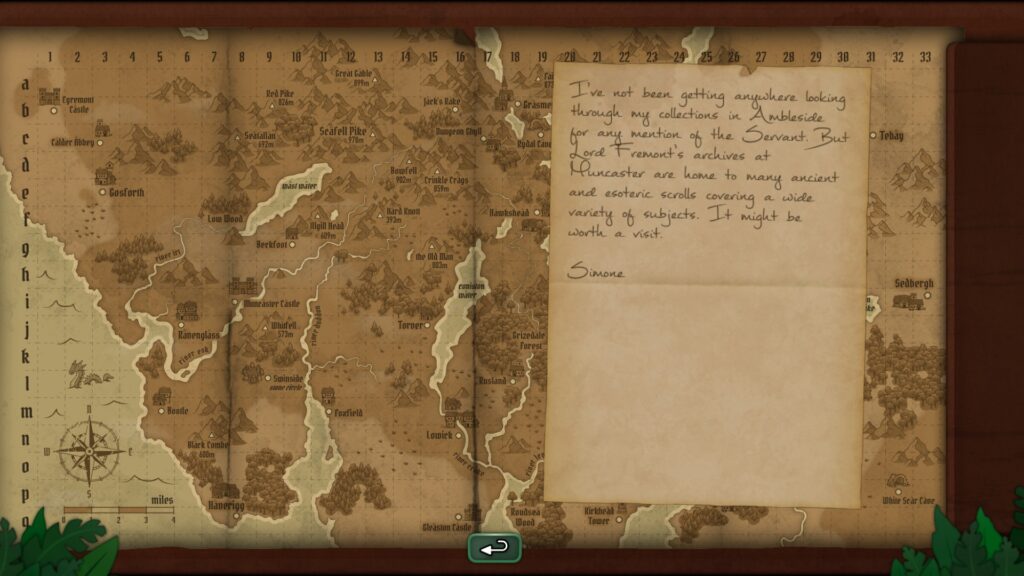
A Little Knowledge is a Dangerous Thing
The player tricks Simone to get information. Getting information from a librarian is normal (encouraged, even!), but librarians cannot always comply. One example is patron privacy. To protect patrons, libraries can choose not to record information about a patron. If the government asked for a patron’s internet activities or check-out history, libraries might not have anything to give.
Simone’s case is strange and hard to compare to real-world situations. First, she’s dealing with the supernatural (there are no regulations for dealing with magical plants). Second, it is unclear whether or Simone was allowed to share what she knew, or that she was even supposed to know. She learned the recipe from Lord Fremont’s private archives. Confidentiality about library materials exists (think the Vatican, the U.S. Capitol, or corporations), but usually there are legal contracts with clear rules and consequences. Simone recognizes the dangers of keeping records, “I should have destroyed that elixir recipe when I had the chance. Whatever happens, you must not allow it to fall into the wrong hands.”
It is worth noting that there is a difference between limiting the sharing of patron information and censorship/limiting the right to information. A library has no right to invade a patron’s privacy, but a patron has the right to access information at the library. Some public libraries have guidelines regarding intellectual freedom. “Intellectual freedom is the right of library users to read, seek information, and speak freely as guaranteed by the First Amendment. Intellectual freedom is one of the core values of the library profession; it promotes access to information and guides the defense against censorship.” This very issue has led to political and physical tension in and around libraries.
Public libraries have progressed (in the U.S.) since their beginnings—I’ve written about patron discrimination in public libraries in another Play the Past piece. As a public space, libraries (ideally) welcome people of diverse backgrounds. It is a place to learn about difficult histories and underrepresented communities. This has become a reason to attack libraries. Librarians, especially public and academic librarians, face issues like racism and sexism. Libraries are a space for people to gather and express ideas, which can range from drag queen story hour to hate speech to book bans. It shows the diversity of the communities libraries serve, as well as the complex expectations the public holds about the library space.
Ironically, though Simone is extremely agile in her research, she is rather clueless about the actual events in the game. In the epilogue, Simone says, “I must admit I’ve been buried in my books and seem to have missed all the excitement. I hear you and your plants had a part to play though.” Perhaps things are calmer at Ambleside Library.
Just Another Day at the Library
Simone is a complex character who plays into some librarian stereotypes while resisting others. She works in a way that would cause real-world librarians to experience burnout, but she also demonstrates real-world reactions and choices that are often glossed over in portrayal of librarians. As Simone helps the player through Strange Horticulture, she is also exposed to harms that mirror threats to real-world librarians, such as poor work-life balance and literal physical dangers. She’s also treated to the harms that come to librarians when they are protecting and managing information. Though Simone is rather a normal character among a fantastical cast, and pretty down-to-earth in an environment with the strangest and most mysterious things, she is rather dynamic in the way she works, talks, and engages with the Strange Horticulture world. Because of this, she’s a useful foil for exploring the complex stereotypes, expectations, and realities of real-world librarianship.
